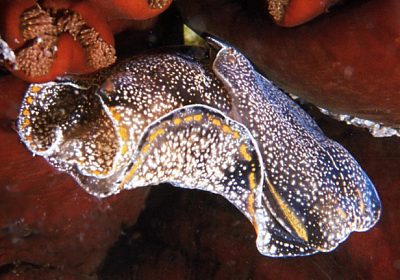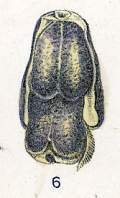
Philinopsis gigliolii
Tapparone-Canefri, 1874
Order: CEPHALASPIDEA
Superfamily: PHILINOIDEA
Family: Aglajidae
DISTRIBUTION
NW Pacific [Japan, China, Russia]
PHOTO
Peter the Great Bay, Russia [Sea of Japan]. Approx. 30mm long. Photo: A. Ratnikov
Philinopsis gigliolii is one of a number of similarly coloured species found in temperate parts of the Pacific. As in Philinopsis troubridgensis and Philinopsis taronga, P. gigliolii had a mottled or reticulate brown pattern on an essentially translucent background. In all species there are patches of yellow. P. gigliolii was originally described from Japan, and there have been few subsequent sightings. This is probably a consequence of its burrowing lifestyle rather than evidence of rarity as most temperate species of the genus are difficult to find. Chaban et al report it feeding on the shelled cephalaspid Cylichnatys angusta.
References:
• Chaban E., M., Martynov A. V. (1998) Melanochlamys diomedea (Bergh, 1893) (Opisthobranchia: Aglajidae), a new genus and species in the fauna of Russia. Ruthenica, 8(2): 147-152 (in Russian).
• Lin Guangyu, Ma Xiutong, Zhang Fusui. (1986) Zoological Encyclopedia of China, Mollusca 3. (Ed. Tsi Chung-Yen). Sci. Publication Publishing: 97 p.
• Rudman W. B. 1972. A comparative study of the genus Philinopsis Pease, 1860 (Aglajidae, Opisthobranchia). Pacific Science, 26: 381-399.
• Tapparone-Canefri C. (1874) Zoologia del viaggio intorno al globo della regia fregata Magenta duranto gli anni 1865-68. Malacologia (Gastropodi, Acefali e Brachiopodi). Stamperia reale di G.B.Paravia e Comp., Torino: 152 p.
Rudman, W.B., 2003 (March 30) Philinopsis gigliolii Tapparone-Canefri, 1874. [In] Sea Slug Forum. Australian Museum, Sydney. Available from http://www.seaslugforum.net/find/philgigl
Related messages
Philinopsis gigliolii from eastern Russia
April 1, 2003
From: Chaban, EM., Chernyshev, AV., & Ratnikov, AV.


Dear Bill,
Philinopsis gigliolii is one of two aglajid species in north-west part of Sea of Japan. The second species is Melanochlamys diomedea reported by Chaban & Martynov {1998). P. gigliolii was described from Japan by Tapparone-Canefri (1874: p. 110, tab. 1, fig. 48 - as Aglaia gigliolii) and transferred to the genus Philinopsis by Rudman (1972: p. 390). It was found in the Yellow Sea (Lin Guangyu et al., 1986: p. 27) and Peter the Great Bay (Chaban, Martynov, 1998: p. 147-150, fig. 1, A-C). In Peter the Great Bay P. gigliolii is very rare species and lives in sand or muddy sand sediments at depths 2-10 m. The body is up to 30 mm in length. The digestive tract of one specimen contained cephalaspids Cylichnatys angusta. (Photo by A. Ratnikov)
References:
Chaban E., M., Martynov A. V. (1998) Melanochlamys diomedea (Bergh, 1893) (Opisthobranchia: Aglajidae), a new genus and species in the fauna of Russia. Ruthenica, 8(2): 147-152 (in Russian).
Lin Guangyu, Ma Xiutong, Zhang Fusui. (1986) Zoological Encyclopedia of China, Mollusca 3. (Ed. Tsi Chung-Yen). Sci. Publication Publishing: 97 p.
Rudman W. B. 1972. A comparative study of the genus Philinopsis Pease, 1860 (Aglajidae, Opisthobranchia). Pacific Science, 26: 381-399.
Tapparone-Canefri C. (1874) Zoologia del viaggio intorno al globo della regia fregata Magenta duranto gli anni 1865-68. Malacologia (Gastropodi, Acefali e Brachiopodi). Stamperia reale di G.B.Paravia e Comp., Torino: 152 p.
Elena M. Chaban,
Zoological Institution, St. Petersburg, Russia,
cem@AM3963.spb.edu)
Alexei V. Chernyshev,
Institute of Marine Biology, Vladivostok, Russia,
tsher@bio.dvgu.ru
Alexander V. Ratnikov,
Institute of Marine Biology, Vladivostok, Russia

Dear Elena, Alexei & Alexander,
It is nice to get a photo of this rarely seen species. I have copied alongside Tapparone-Canefri's figure [from Pilsbry 1896, Pl. 1, fig 6]. It is interesting that there are a number of very similarly coloured species of Philinopsis found in temperate parts of the Pacific. For example, In southern Australia we have Philinopsis troubridgensis and in sthn Australia and northern New Zealand there is Philinopsis taronga. Now that I have seen colour photos of P. gigliolii, I must say it is extremely similar to P. taronga in colour pattern. If it were not for their being poles apart geographically, I would seriously consider whether they were the same species.
Best wishes,
Bill Rudman
